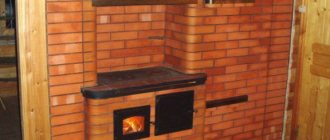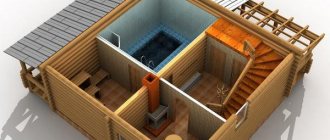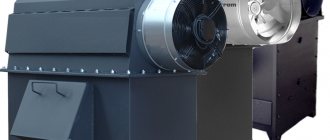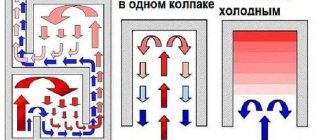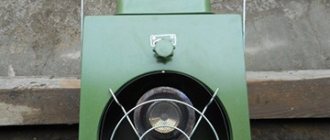The need for heating in a garage rarely causes controversy: motorists understand perfectly well how important it is to take care of the condition of the car, and they themselves do not want to freeze during inspections and repairs of equipment.
The main issue that needs to be resolved is the selection of the appropriate type of heating. A good option is a miracle diesel stove - the unit is easy to assemble and economical to operate. And these are important criteria for organizing garage heating.
Before you decide to assemble a stove, you need to understand its structure and operating principle, don’t you agree? In the article, we outlined the identified points in detail, and also provided several options for assembling a home-made unit. Step-by-step instructions will help you build a stove and organize efficient heating of your garage.
Fuel storage
Diesel heating requires the organization of a tank to store fuel and supply it to the equipment.
The location for its placement is determined for reasons of fire safety. Convenient access must also be provided to refill the tank. To organize a place for fuel storage, you can dig a pit, the bottom of which is covered with a cement-sand cushion. This is a layer of about 20 cm. This distance should remain between the walls of the container and the walls of the pit. The pit is filled with a cement-sand mixture. Compaction must be done every 20 cm, water must be added.
Fuel storage and diesel boiler
You should not save on capacity for heating equipment. If you make it yourself, cracks may occur, which will result in fuel leakage, which means high costs. Therefore, it is recommended to use certified containers.
You can use not one diesel tank, but several, connecting them with a special harness. Nowadays, tanks made of polyethylene lined with steel sheet are very popular. You can also use a reinforced fiberglass container.
If the diesel boiler is located below the tank level, then a gravity fuel supply system can be used. If the level is the same or the container is slightly higher than the burner of a diesel stove, the burner pump is able to independently suck in diesel. If the difference in levels is more than 5 meters, additional help is needed.
Fuel storage heating systems using a diesel boiler
If there is a fairly large distance between the container and the boiler, the fuel line runs outside, it should be buried 1.5 meters into the ground. This is necessary to prevent freezing.
Design features and operating principle
Diesel stoves for the home or garage have great advantages, especially in the conditions of the domestic winter. Since their main advantage is the rapid heating of air, even in an unheated room.
Heating boilers using diesel fuel
Today, consumers are offered heating boilers running on diesel fuel, which are completely similar in operation to turbocharged gas appliances. That is, the air pumped by an inflatable fan is mixed with diesel oil and thus forms a fuel-air mixture. After this, it enters the firebox and, together with the oxidizer, is ignited by the electronic ignition system. During the combustion process, the solarium gives off its energy to the heat exchanger, through which the coolant passes.
With traditional gas boilers, which are used as a heater for residential premises, diesel fuel appliances are also similar in that they are easily controlled electronically in automatic mode. The fan rotation speed, fuel supply process and ignition can be controlled by a specially programmed thermostat, maintaining the required temperature in the house.
Diesel stoves
Today, consumers can purchase compact heaters that run on diesel fuel. They are called potbelly stoves equipped with fans.
They can be presented in two varieties:
- Direct heating - the devices do not have a chimney, which makes them inconvenient for heating a garage or other small space.
- Indirect heating is a convenient device that has gained popularity among garage owners. The design of the fuel tank and combustion chamber works on a fairly simple principle - through the fuel tank nozzle, liquid enters the chamber, where it is then burned using air supplied by a fan. After passing through the heat exchanger, the air flows are directed through the nozzle into the room, heating it evenly and quickly.
The design of the potbelly stove includes:
- Removable fuel tank, which is equipped with a valve.
- Adjustment screw.
- Replaceable block with wick.
- Frame.
- Lattice.
- Burner.
- Reflector.
Liquid fuel heater
As a rule, a modern diesel stove is equipped with a special flame control system that automatically turns off an overheated device. Such mobile devices are ideal for heating various rooms:
- Change houses, garages, construction sites or security posts.
- Shopping facilities.
- Country houses and other small residential premises.
Mobile potbelly stoves will become indispensable when it is necessary to heat a room that is in disrepair, as well as during a hike to organize heating in a tent when there is no desire to make a fire. Choosing such a stove will be the optimal solution for creating the necessary microclimate. Such a device can serve as an additional source of heating or as a main heater, which can also be used to heat food.
Features of operation
Before lighting a diesel stove, you need to install the tank in the right place and fill it with fuel. The next step is to remove the burner grate and install the wick into the block. After this, the burner and grate are reinstalled, the adjusting screw is opened and after 30 seconds the burner can be ignited. After intense combustion begins, you will need to tighten the adjusting screw all the way and wait a little for the flame to settle. Then open it back, setting the desired degree of heating.
The device is turned off by screwing in the screw until it stops. In this case, you need to make sure that the diesel fuel burns out completely and the fire goes out completely.
Feedback about use
Evgenia, Novaya Ropsha village, Leningrad region. We use this stove. We use it for the greenhouse in the spring during severe frosts. There is a smell from it all the time, although the store said that it was only at the beginning. Also, I have buckets of water in my greenhouse as heat accumulators. After the stove operates on water, a gasoline film appears. Our device is adjusted perfectly, but there are these unpleasant little things. I wouldn't use it inside the house.
Alyonushka, St. Petersburg. We have such a thing at home. My husband is very pleased with it, simply delighted. True, at first there were problems with it, it burned poorly, or something else was wrong, but over time everything got better. As for me, my husband has problems with charm, it stinks disgustingly, and makes a buzzing sound. But when there is no electricity, it helps a lot.
Alexey Petrovich, Moscow. I use the unit in the kitchen or in the hallway, I don’t leave it overnight, so everything functions quite well and brings the cold dacha to a normal and comfortable place to live. There is a smell, but if you compare it with the summer smells of Moscow, it’s just flowers. There are no difficulties with control. You just need to keep an eye on the filter so that it doesn’t burn out too much, otherwise it will cause unstable operation with soot or a yellow flame. Excellent ratio of price, quality and benefits.
Angelina, Moscow. We have been using the burner for 4 years now. It works great in May and October. There is, of course, a gas stove, but it warms up the room very slowly. Sometimes we even cook with it. If you consider the price, heat and speed of work, then it is simply priceless during the construction period. This year we will install Bulleryan, but these 4 years it has helped us out a lot.
Ahela, Moscow. Maybe in advertising the device can be called a miracle oven. We use it in the cabin when necessary, since there is no electricity yet. We even got used to adjusting it, but when it works, I feel like a truck driver, it seems to me that there is exactly the same smell coming from the inside of the cabin.
Principle of operation
Liquid fuel (this can be not only diesel, but also kerosene) enters an annular tank with fuel, where a fiberglass wick is rolled up.
The wick is soaked and burns, with a burner placed above it.
The gaseous mixture enters the combustion chamber (a system of cylinders with a large number of jumpers, holes, etc.), where it burns out layer by layer and evenly.
The design of the cylinders in the combustion chamber allows the use of convection and infrared heating mode. These stainless elements heat up to 800 °C and heat the air, infrared rays (length 620 -700 nm) are reflected from the mirror screen and directed into the room, and heat objects.
Combustion in this device takes place practically without open flame. You can determine whether the process is going correctly by eye.
The flame should not rise above the protective grill (both the grill itself and the wick can burn).
Self-production
To do this, you will need a tank with a volume of at least 2 liters. There will be no smoke or soot during stove operation. During the process of igniting the stove, it will, so this process is recommended to be carried out outdoors.
Diesel from the fuel tank enters the wick cup. Using the dispenser, you can regulate the amount of incoming fuel. In the combustion cup, the fuel is heated until a gaseous mixture is formed, which then enters the combustion chamber. The spiral, which is located at the top of the chamber, is heated to a temperature of 800 °C. The smoke escapes through the chimney.
Please note: the chimney is made collapsible for further convenience when cleaning it from soot.
You can make your own apparatus weighing six kilograms. Diesel fuel is a fuel with a fairly high density, so its consumption is minimal. Overall, this stove is an efficient and easily transportable design.
Device
- Removable fuel mixture container. The container has a valve.
- Wick and part of the block.
- Frame.
- Burner.
- Screw for adjustment.
- Lattice.
- Reflector.
A reflector made of metal material is mounted on a body that is painted with a powder-type paint. Due to this element, the house is heated most well.
You might like the article about the Sudarushka stove with a cast iron firebox. You can read about fuel consumption in a pellet boiler here. You may also find this article about the potbelly stove POV-57 useful.
The burner itself is installed in the central part of the device, and diesel fuel is supplied independently from the fuel tank, which is installed on the rear panel. The adjustment screw is necessary to set the appropriate temperature when heating the house. All stoves are made of material that is resistant to high temperatures.
The working principle of the miracle stove
The miracle stove is designed to heat rooms for a long time with minimal fuel consumption.
The wood-burning stove is equipped with two chambers. In the first chamber, the smoldering of firewood is ensured under conditions of limited access to oxygen; in the second chamber, secondary combustion occurs. Here the released flammable gas is burned. Thus, the furnace allows you to use the thermal energy released during combustion to the fullest extent. The efficiency level of such a stove reaches 75% (the efficiency of classic potbelly stoves barely reached 15-20%). The pyrolysis process increases the combustion period of wood. Therefore, one load of firewood is enough to operate the stove for 6 hours, and with proper settings – up to 8 hours. Heating of the room is carried out by heating the air against the furnace body.
This model has a number of positive properties
- Capable of working on all types of solid fuel - firewood, wood chips, peat briquettes, wood products;
- Heats the entire room evenly;
- Allows the home owner not to depend on centralized supplies of gas and electricity;
- Provides control over the fuel combustion process;
- Does not require significant costs for system installation;
- You can cook food and heat water on the surface of the stove;
- It is easy to maintain on a daily basis;
- It is characterized by low cost.
Such wood-burning stoves can be used for quick heating and stable heating of country houses, residential buildings, greenhouses, workshops and small businesses.
Blitz tips
- When buying a miracle stove, opt for a metal burner type. It can be used as a cooking surface. The glass type of burner, although more efficient, requires special care; if a drop of water gets on the surface, the glass may burst.
- Monitor the condition of the wick. Its timely replacement and periodic impregnation in kerosene will allow you to avoid problems in the operation of the device for a long time.
- Be sure to buy a fire extinguisher to quickly put out a fire and prevent a fire.
Proper operation and compliance with fire safety standards when using a miracle stove will allow you to quickly, economically, and most importantly, effectively heat the room.
Diesel stove for the garage
The drip stove is suitable for basements, small rooms, country houses, garages, greenhouses where there is no heating or electricity.
Building a stove with your own hands is a fairly accessible and inexpensive activity. How to make a diesel-powered drip stove yourself will be discussed in our article.
Distinctive features
A stove assembled by yourself has a number of advantages:
- it saves fuel;
- if desired, you can design a stove of any size, which will be the most suitable option for a given room;
- easy to transport;
- ease of use;
- The oven dripper can be used for cooking. To do this, when constructing a stove, the pipe is placed on the side.
Diagram of a diesel-powered dropper stove. This is a very economical design. Complete combustion of compounds occurs in the furnace chamber
When making a drip stove with your own hands, you need to follow fire safety precautions:
- the device must be located in a draft-free room;
- flammable objects should be absent near the stove; it is advisable to have free space next to it (about half a meter);
- Do not use water to extinguish or cool the stove.
Materials needed to build the furnace:
The main tools that will be useful for the job are a welding machine, a drill and a clamp.
A popular do-it-yourself device is a drip stove made from a gas cylinder
How the device works
In the lower tank, the fuel boils after five minutes of operation. The oil vapor enters the next compartment, which is called the burner. There, for better combustion, the steam is enriched with oxygen.
The principle of drip feeding of waste into a bowl (click on the picture to enlarge)
Then, combustion products enter the upper compartment, and from there into the chimney. The highest temperature is in the upper module of the drip furnace.
Self-production
To do this, you will need a tank with a volume of at least 2 liters. There will be no smoke or soot during stove operation. During the process of igniting the stove, it will, so this process is recommended to be carried out outdoors.
Diesel from the fuel tank enters the wick cup. Using the dispenser, you can regulate the amount of incoming fuel. In the combustion cup, the fuel is heated until a gaseous mixture is formed, which then enters the combustion chamber. The spiral, which is located at the top of the chamber, is heated to a temperature of 800 °C. The smoke escapes through the chimney.
You can make your own apparatus weighing six kilograms. Diesel fuel is a fuel with a fairly high density, so its consumption is minimal. Overall, this stove is an efficient and easily transportable design.
Waste oil dripper stove
One type of cheap fuel is used oil. The stove can heat up to 800-900 °C. At the outlet the temperature will be 90 °C.
Pour a portion of oil and add 50-100 g of ignition agent (special fluid, heating oil, kerosene or diesel fuel). This is necessary to quickly ignite the stove. Wait until the combustion process stabilizes. Then you can pour in the next portion.
If there is any spilled oil, it must be removed immediately. Combustion occurs inside the pipe. This is a safe process. Fuel consumption is from 0.5 to 1.5 liters per hour. When the stove lights up, you can heat the water.
Waste oil dripper stove
Recommended for use: diesel oil, fuel oil, waste oil, heating oil. Do not use gasoline, acetone or other solvents. Avoid getting water into the fuel.
Special literature contains a large number of detailed instructions on how to make a drip stove with your own hands. Each of these designs is unique and has its own advantages and disadvantages. You can also use a store-bought version of the stove, but modify it at your own discretion.
Do it yourself
Building a heating device yourself is a very costly, time-consuming and labor-intensive process. It justifies itself only when its cost is lower than the price of factory development. For a miracle oven, this process is unjustified, but everyone decides for themselves what is best.
There are several types of diesel heaters.
Gas cylinder heater
For production you will need:
- A balloon without seams with a wall thickness of less than 1.5 cm.
- Chimney pipes 4 m long and over 10 cm in diameter.
- Fuel tank with a capacity of up to 15 liters.
- Copper pipes.
- Grinder and welding machine.
- Steel angles.
The process of supplying diesel fuel proceeds by gravity. It does not require additional elements to warm the air. The combustion source must be at the same height as the circuit. This prevents the oven from overheating to a fire hazard temperature.
Manufacturing instructions:
- Using a grinder, cut the balloon into two even pieces. One of them will serve as a cover, the second as a camera.
- Weld metal corners to the chamber to form legs.
- Using a welding machine, make a small hole in the lid for an exhaust pipe with a diameter of 10 cm. The hole should be made at a distance of 15 cm from the edge.
- Make a small hole in the housing, which will be used to regulate air flow. It will be covered by a special plate.
- Measure 10 cm from the welding point and make a hole 3 mm in diameter at the resulting point. Using this principle, 10 more holes should be made, the last of which will be located at a distance of 0.5 m from the welding point.
- Drill a hole in the pipe for a pipe with a diameter of 8 cm and a length of 4 m. It should be mounted parallel to the floor and welded well.
- To fill the fuel liquid, an additional hole with a diameter of no more than 8 cm should be made in the lid.
The combustion source must be at the same height as the circuit, this helps prevent the stove from overheating to a fire-hazardous temperature
Drip type stove
An oven with a drip operating system is very easy to manufacture. As a rule, it is used to heat a small area of rooms.
Manufacturing instructions:
- Make a preliminary calculation of the area that will be heated. For example, for a room measuring 3 by 3 meters, a box with dimensions of 30x30x45 cm will be sufficient.
- For a small stove, you can use a fire extinguisher container; for larger stoves, you can use a 200-liter container.
- For a container for diesel fuel, a container with a volume of 2 liters is sufficient; for example, you can use an ordinary medical burner. To connect it, connect the rubber hose of the burner at an angle of 90 degrees with a copper pipe with a small diameter and a length of 1 m.
- The hose should be bent in half and secured with a clamp to secure the stove parts. The adjusting screw should be mounted so that the flow of liquid is drip.
- Instead of a wick, you can use a rag soaked in diesel fuel.
- Install the door.
- Make a hole in the center of the body to match the diameter of the copper pipe.
- If you plan to use the device for cooking, you should mount the tube not from the top, but from the side.
Solarogaz company equipment
The line includes a little more than half a dozen models of heaters that use diesel fuel and kerosene as fuel. Whatever is sold at gas stations and hardware stores will do. Regardless of design and weight, the consumption of Solarogas heaters is 0.2 liters per hour. The capacity of the tanks varies, on average it is enough for 10 hours of continuous operation. With a power of 1.8 - 2.5 kW, the latter looks much more attractive than gas, where you have to pay 70 rubles for every three hours of operation. If you do the math, the savings are up to three times, which is quite noticeable with frequent trips to nature.
We remind you that the Solarogas heater is intended for transportation in the trunk of a car. The weight of the smallest device in the line is 4.3 kg, which together with fuel is already approaching 7 kg. You simply can’t carry that kind of weight in a backpack. Adding to the above the considerable dimensions of the device, we get the specifics of use. Solarogas heaters are equipped with a filling tank, the capacity of which varies depending on the model. The temperature of the fuel inside does not rise above 35 ºС even at maximum combustion power. This is enough to avoid an explosion.
Heaters are ignited with a match or burning paper. Required:
- lift the divider with the mesh;
- open the fuel regulator;
- bring a burning match;
- After sunbathing, put the divider with the mesh in place.
The simplicity of the device makes the unit attractive for hiking purposes. The firebox is protected by a durable angular grille, the reflector reflects some of the heat forward, over the burner you will warm and cook food
The bottom of the case does not heat up much during operation, however, follow the usual precautions when handling devices of this kind. Let us briefly describe the line of Solarogas heaters
- KO – 1.8 Mini produces a maximum power of 1.8 kW on the burner. Fuel consumption is no different from other models, 0.2 liters per hour. With a fuel tank capacity of up to 2.5 liters, fuel is enough for 18 hours of leisurely work. The weight of the diesel fuel heater is 4.3 kg. The peculiarity of the design is that the firebox is open on three sides; you will warm up well near the device. The flame is surrounded by a ceramic cylinder, which protects the fire from the wind and serves as a heat accumulator. On top there is a protective mesh that emits in the infrared spectrum. The emphasis is on cooking in a close circle of people. Device dimensions 0.3x0.3x0.3 m.
- KO – 1.8 Caprice is distinguished by a reflector covering the firebox on three sides. Due to this, most of the heat is directed forward and upward. The rest of the design is similar.
- Software - 2.5 Mini produces a burner power of 2.5 kW, consumption - 0.2 liters per hour. The firebox is open on three sides and surrounded by a steel cylinder. Weight and dimensions are the same as previous models.
- PO – 2.5 Mini+ is distinguished by a fireplace surround made of steel mesh. Thus, the emphasis is on infrared heating of the surrounding space. The firebox is open on three sides; food is cooked on top.
- PO – 2.5 Savo differs from the previous model in that it has a steel cylinder around the hearth and a reflector surrounding the firebox on three sides. The weight of the device is 5.6 kg, with dimensions of 0.37 x 0.42, x 0.32 m. In appearance, the wide diesel heater resembles a kind of barbecue, and associations with cooking are born.
- PO – 2.5 Savo+ is distinguished by a mesh surrounding of the hearth, which indicates intense infrared heating of the surrounding space.
- PO – 2.5 The fireplace is the largest in the line (6.7 kg), made in the form of a rectangular fireplace. It is difficult to cook food; the appliance is not designed for this. Ideal for heating a dacha.
The manufacturer provides a three-year warranty on the equipment. Check with dealers for prices. The company has a certificate for the use of equipment in residential premises. We are somewhat skeptical about the fact that inside a room with European-quality renovation there is an open flame burning from the hearth. The ceiling will quickly become smoked, no matter how clean the diesel fuel is. Diesel fuel also contains a percentage of sulfur. Recently, directives have been adopted across Europe to reduce the concentration of a dangerous element that negatively affects health and in every possible way contributes to the destruction of road surfaces.
For nature, equipment powered by diesel fuel will come in handy
Summer residents, please note that it is possible to cook food with relative safety using this equipment. Do this on the veranda, the food will turn out delicious
Note the reasonable cost of the method and the amazing mobility of the equipment, unlike a gas stove. The price of the devices starts from 2,300 rubles; if you find a car with a diesel engine, we recommend Solarogas heaters.
Types of heaters
Depending on the principle of operation, there are two completely different types of devices. All such units can be divided into devices of direct and indirect action.
In the first case, the design is simplified as much as possible. There are no additional filters or air vents. This leads to the fact that waste combustion products enter directly into the room. Such units are prohibited from being used in residential areas. Such devices can only be used in industrial areas or for temporary work at low temperatures.
In the second case, the design provides a chimney, which additionally cleans the air from combustion products. In addition, such units have an additional filtration system. Such autonomous heaters can be used in closed residential areas.
TOP 3 best diesel heaters Ballu
- Ballu BHDP-20
- Ballu Biemmedue EC 85
- Ballu BHDP-100
Diesel infrared heater
Such devices are most often used when it is necessary to quickly obtain heat where there are drafts. The principle of its operation is similar to exposure to direct sunlight. An infrared heat boiler does not heat the air, but the objects around it. When objects heat up, they release the resulting heat into the air and it also gradually warms up.
Heaters of this type are installed on open terraces, winter verandas of cafes and restaurants. Infrared heaters differ from a conventional diesel heater in the presence of a heat emitter and a heat reflector. Diesel infrared stoves do not require a smoke exhaust system. They are very effective and economical.
Their only drawback is the inability to quickly warm up a large room. But you can get heat quickly, literally within a few seconds after turning on the device.
Air heat gun
This type of diesel heater is used when it is necessary to provide heating for a large area. Large volumes are quickly warmed up due to the powerful flow of warm air pumped by the fan.
The body of the heat gun is made of durable metal. This helps provide reliable protection against mechanical damage. The thermal energy obtained from the combustion of diesel fuel is used to heat a ceramic or metal element, which is blown by a stream of air.
The heat in the room will remain as long as the device is operating. If you turn off the heat gun, the air in the room will begin to cool quickly. This unit is very effective for large rooms, isolated from drafts and additional air flow.
Such diesel heaters are perfect for a summer residence, but they cannot be called completely energy independent. They still require electricity to operate. It is used to operate a security system: controllers for temperature, flame level and fuel consumption. When used correctly, the devices are completely safe. In case of overheating, the device automatically turns off.
Kerosene heater
These devices are indispensable in extreme conditions. They are capable of operating only on kerosene and do not require an additional source of electricity. This is an excellent option in cases where there is no electricity in the house or there is no gas pipeline.
The kerosene heater is also very popular among tourists. It is convenient to take it with you on a hike: to the mountains or fishing. With its help you can not only heat the tent, but also prepare tea or fish soup.
Waste oil dripper stove
One type of cheap fuel is used oil. The stove can heat up to 800-900 °C. At the outlet the temperature will be 90 °C.
Pour a portion of oil and add 50-100 g of ignition agent (special fluid, heating oil, kerosene or diesel fuel). This is necessary to quickly ignite the stove. Wait until the combustion process stabilizes. Then you can pour in the next portion.
If there is any spilled oil, it must be removed immediately. Combustion occurs inside the pipe. This is a safe process. Fuel consumption is from 0.5 to 1.5 liters per hour. When the stove lights up, you can heat the water.
Waste oil dripper stove
This is important to know: fuel for drip furnaces must fit the “oil” category.
Recommended for use: diesel oil, fuel oil, waste oil, heating oil. Do not use gasoline, acetone or other solvents. Avoid getting water into the fuel.
Special literature contains a large number of detailed instructions on how to make a drip stove with your own hands. Each of these designs is unique and has its own advantages and disadvantages. You can also use a store-bought version of the stove, but modify it at your own discretion.
Watch an overview video about the diesel drip stove:
video
Manufacturers
Long gone are the days of shortages, when any product was difficult to buy. Today, in household appliance stores, in supermarkets, and on the Internet, you can buy a miracle electric oven of different types.
The device can replace a whole set of kitchen utensils, saving time and the family budget. With such an electric frying pan, for every woman any dish will become a real masterpiece, a work of art.
The Russian analogue of the miracle stove is the Czech model Remoska, made from environmentally friendly materials without the addition of harmful impurities. The modernization has retained the simplicity, laconic design and reliability of the device.
The Czech analogue can replace a frying pan, microwave, toaster, stove, oven, grill, steamer. The manufacturer guarantees long service life and 100% European quality.
Original
There are several types of old-style electric furnaces on sale:
- Electric furnace Miracle with a capacity of 2 liters and a power of 500 kW;
- Miracle electric furnace with a capacity of 3.5 liters and a power of 800 kW;
- Electric furnace Miracle with a capacity of 5 liters and a power of 1000 kW.
Analogs
More modern models have appeared with additional functions:
- Model SMILE EFP – 1190, its power is 1500 W, diameter 36 cm, depth 4 cm. Equipped with a non-stick coating, glass lid, thermostat and temperature controller;
- Model Sakura SA – 7704, power 1300 W, diameter 32 cm, depth 9 cm, with non-stick surface and tempered glass lid;
- The Sorceress - 6 electric frying pan has a size of 30 X 30 cm, a power of 1500 W, a depth of 6.5 cm, a non-stick coating and a lid made of heat-resistant material. The only model that does not have an upper heater is more suitable for stewing and frying, so the miracle stove is not used for baking. The model range of the Sorceress stove is available in 6 modifications. Thanks to the Teflon coating, food does not stick, you can cook without adding oil and fat, which means the food will be much healthier and nutritious. Almost all types are round in shape, made of Teflon or ceramics, diameter from 34 to 38 cm, depth from 4 to 7 cm.
More expensive models have a temperature control, and some can even make jam. Non-electrical components can be washed in the dishwasher.
Fuel consumption for heating
The amount of diesel fuel that the boiler will consume hourly during the coldest period of the year should be calculated using the formula:
P = Q / (q * efficiency),
Where
- P – hourly fuel consumption, l/h;
- Q – heat loss of the building at the lowest temperature outside, kW;
- Q – the lowest calorific value of 1 liter of diesel fuel, we take q = 12 kW*h/l;
- Efficiency is the efficiency of the installation, we take efficiency = 0.92.
Determining heat loss Q is not an easy task. Today, there is a widespread misconception that for this it is enough to multiply the area of the building by 0.1 kW. That is, a house with an area of 100 square meters. m will lose 10 kW of heat, an area of 200 sq. m - 20 kW, etc.
To understand that this technique is extremely inaccurate, it is enough to take into account at least the fact that for buildings located at different latitudes and, accordingly, in different climatic conditions, the amount of specific heat loss simply physically cannot be the same.
A full calculation of heat loss takes into account a number of factors:
- lowest temperature in winter;
- thermal conductivity of enclosing structures (depends on the properties of the base material and insulation);
- total area of window openings;
- the orientation of the building relative to the cardinal points (the amount of solar heat entering through the windows depends on this);
- the amount of heat generated by equipment located in the building.
It is best to order such a calculation from an experienced engineer - an employee of a construction or design company. But if you want, at the very least, you can master it yourself. To do this, you will need to read specialized literature or look into SNiPs “Heating, ventilation and air conditioning”, “Building climatology”, etc.
If the boiler is also used to heat water, then the heat loss Qw will need to be added to the heat loss Qw. This value is determined by a simple formula:
Qв = (s * m * dT) / (3600 * 1000),
Where
- Qв - average heat consumption for heating water, kW;
- C—specific heat capacity of water, J/kg*C;
- M - mass average hourly consumption of hot water, kg/h (daily consumption must be divided by 24);
- dT is the temperature difference between heated water and cold water entering the house, C.
The above formula cannot be used to calculate the total fuel consumption for the season, since it only takes into account the lowest winter temperature. To determine the supply of diesel fuel for the winter, the consumption of P is usually halved. For example, if the amount of heat loss during the coldest five-day period, according to the calculation results, was 18 kW and the hourly fuel consumption under these conditions is equal to
P = 20 / (12 * 0.92) = 1.81 l/h,
then the total consumption for a heating period lasting 200 days will be:
Rtotal = (P/2) * 200 * 24 = (1.81 / 2) * 200 * 24 = 4344 l.
Note that the accuracy of this technique also leaves much to be desired. It would be more correct to determine the flow rate based on the average winter temperature characteristic of a given region.
Features of ignition and maintenance of furnaces. Rules for safe operation
Before igniting the stove, inspect the lower container for the presence of water in it. If necessary, moisture is removed, after which 1–2 liters of used motor oil are poured into the module through the filling opening. Light the fuel through the same hole using a wick made of steel wire and an oiled rag. After the oil flares up (usually this takes from three to five minutes), the air supply hole is covered, leaving a gap 1–2 cm wide. The optimal adjustment is considered to be the state of the unit on the verge of boiling liquid fuel. In this case, intense evaporation of the flammable substance is observed, due to which the furnace operates at maximum power.
It should be remembered that an oil stove, like other heating equipment with an open flame, is a fire hazardous structure. When operating a liquid fuel stove, you should follow the rules of safe operation:
- Preparing the stove for operation must necessarily include checking the presence of draft. To do this, bring a lit match to one of the burner holes. If its flame deviates inward, then you can start igniting. Otherwise, you will need to clean the unit’s channels and chimney to ensure normal air pressure.
- It is forbidden to shake the waste before refueling. Water or antifreeze that gets into the oil causes fuel to splash through the burner injection holes.
- The fuel level should be no more than ¾ of the height of the primary chamber. It is better to refuel the oven in advance. This will allow the oil to settle.
- The use of gasoline, thinners and other flammable lighter fluids is prohibited. It is better to use diesel fuel or kerosene, which is used to moisten paper or rags.
- Oil accidentally spilled near a heating device must be immediately removed from the floor.
- It is strictly prohibited to use water to reduce heat or stop the burning of oil.
We should not forget about fire extinguishing agents. There must be a fire extinguisher and a container of sand near the stove.
Modernization of liquid fuel heating devices
The types of stoves described above can be used to heat garages and outbuildings, but not residential premises. To use this type of heating device for a residential building, it must be modified.
More often, the design is changed to convert the unit from convective to water heating. Why is the upper module equipped with a built-in heat exchanger, through which coolant from the heating system of the house will be passed? To do this, it will be necessary to purchase steel sheet and three-quarter or one-inch pipes.
Note: When additionally equipped with a horizontal chimney casing, the heating efficiency of the coolant liquid will increase.
The second option is to install a heat exchange manifold, which is connected to a fan. The outlet pipes of the air collector will help distribute heat throughout all rooms. This device is conveniently placed in the basement of a building.
With such modifications, the stoves cannot be operated without ventilation turned on. Otherwise, the coolant may boil or depressurize and warp the outer casing.
Miracle diesel oven
This original name was assigned to this type of small liquid fuel stoves by manufacturers and sellers. Naturally, in order to attract a lot of buyers to their products. There is nothing miraculous about such heaters, since they are a modern embodiment of the well-known kerosene gas. Thanks to this, a mini-stove can please its owner with low diesel consumption. For example, a heater with a thermal power of 2.5 kW consumes about 0.2 liters of diesel per hour (manufacturer’s technical data).
The stove has very small dimensions, and the weight of the most powerful models does not exceed 10 kg. The design is simple: an open reservoir and a fuel tank are located in a metal case, connected to it according to the principle of communicating vessels. To prevent diesel fuel from flowing out of the tank uncontrollably, the outlet pipe is equipped with a special valve. A simple and reliable burner for a stove running on diesel fuel was precisely what she inherited from kerosene gas. It is a wick, the lower part of which is immersed in a tank with liquid fuel.
If you open the valve and supply fuel to the working container, the wick wound on a cylindrical base will quickly absorb it. After some time, the miracle diesel stove is ignited manually, after which you still need to wait until it warms up and reaches operating mode. The power is regulated by a valve, and with its help the heater is turned off.
True, the burner goes out after 5-10 minutes, when all the diesel fuel has burned out. Most manufacturers place a steel grate on top of the burner so that they can heat water in a pan or bucket if necessary. A striking example of a miracle stove is the Solarogaz PO-1.8 unit with a power of 1.8 kW, produced in Russia, which is shown in the photo.
According to user reviews on the forums, the device is not bad, but there are a number of caveats:
- to avoid a pungent odor indoors, it is better to ignite the miracle stove outdoors;
- due to the same smell, it is not recommended to use the product for heating residential premises on an ongoing basis;
- During intensive use, it is necessary to clean the burner and change the wicks frequently.
Precautionary measures
As a precaution, you should purchase a small carbon dioxide fire extinguisher. The volume of the fire extinguisher should, according to calculations, exceed the cubic capacity of the room by 1.5 times.
A fire extinguisher weighing 5 kg is considered optimal. Of all the types, it is preferable to choose the following models:
- carbon dioxide;
- automatic;
- non-volatile.
It is not recommended to experiment with different types of fuel. It is best to use the type that is indicated in the product passport.
Rules for calculating fuel consumption
In order to correctly calculate all expenses and not waste most of the funds, it is recommended to consider the following rules:
- in a relatively warm region, it will be enough to install a device whose thermal energy is calculated according to the principle of 1 kW/10 m². This will be enough to ensure full heating of the room;
- Judging by calculations, one liter of solar oil can provide a residential building with ten kilowatt-hours of energy. Accordingly, in order to fully heat a house with an area of 100 m², it is necessary to burn one liter of fuel every hour;
- experts say that with the correct calculation of the operation, the device can function normally even at half its power, so not one, but half a liter of diesel fuel will be enough to provide good heating to the house.

